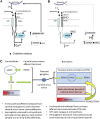Hypoxia-induced changes in protein s-nitrosylation in female mouse brainstem
- PMID: 24922346
- PMCID: PMC4370248
- DOI: 10.1165/rcmb.2013-0359OC
Hypoxia-induced changes in protein s-nitrosylation in female mouse brainstem
Abstract
Exposure to hypoxia elicits an increase in minute ventilation that diminishes during continued exposure (roll-off). Brainstem N-methyl-D-aspartate receptors (NMDARs) and neuronal nitric oxide synthase (nNOS) contribute to the initial hypoxia-induced increases in minute ventilation. Roll-off is regulated by platelet-derived growth factor receptor-β (PDGFR-β) and S-nitrosoglutathione (GSNO) reductase (GSNOR). S-nitrosylation inhibits activities of NMDAR and nNOS, but enhances GSNOR activity. The importance of S-nitrosylation in the hypoxic ventilatory response is unknown. This study confirms that ventilatory roll-off is virtually absent in female GSNOR(+/-) and GSNO(-/-) mice, and evaluated the location of GSNOR in female mouse brainstem, and temporal changes in GSNOR activity, protein expression, and S-nitrosylation status of GSNOR, NMDAR (1, 2A, 2B), nNOS, and PDGFR-β during hypoxic challenge. GSNOR-positive neurons were present throughout the brainstem, including the nucleus tractus solitarius. Protein abundances for GSNOR, nNOS, all NMDAR subunits and PDGFR-β were not altered by hypoxia. GSNOR activity and S-nitrosylation status temporally increased with hypoxia. In addition, nNOS S-nitrosylation increased with 3 and 15 minutes of hypoxia. Changes in NMDAR S-nitrosylation were detected in NMDAR 2B at 15 minutes of hypoxia. No hypoxia-induced changes in PDGFR-β S-nitrosylation were detected. However, PDGFR-β phosphorylation increased in the brainstems of wild-type mice during hypoxic exposure (consistent with roll-off), whereas it did not rise in GSNOR(+/-) mice (consistent with lack of roll-off). These data suggest that: (1) S-nitrosylation events regulate hypoxic ventilatory response; (2) increases in S-nitrosylation of NMDAR 2B, nNOS, and GSNOR may contribute to ventilatory roll-off; and (3) GSNOR regulates PDGFR-β phosphorylation.
Keywords: N-methyl-D-aspartate receptor; S-nitrosoglutathione reductase; hypoxic ventilatory response; neuronal nitric oxide synthase; platelet-derived growth factor receptor-β.
Figures






Similar articles
-
Brain stem NO modulates ventilatory acclimatization to hypoxia in mice.J Appl Physiol (1985). 2007 Nov;103(5):1506-12. doi: 10.1152/japplphysiol.00486.2007. Epub 2007 Aug 9. J Appl Physiol (1985). 2007. PMID: 17690195
-
Ventilatory responses during and following exposure to a hypoxic challenge in conscious mice deficient or null in S-nitrosoglutathione reductase.Respir Physiol Neurobiol. 2013 Feb 1;185(3):571-81. doi: 10.1016/j.resp.2012.11.009. Epub 2012 Nov 24. Respir Physiol Neurobiol. 2013. PMID: 23183419 Free PMC article.
-
Enhancing S-nitrosoglutathione reductase decreases S-nitrosylation of ERO1α and reduces neuronal death in secondary traumatic brain injury.Nitric Oxide. 2025 Feb;154:29-41. doi: 10.1016/j.niox.2024.11.005. Epub 2024 Nov 19. Nitric Oxide. 2025. PMID: 39566653
-
The role of S-nitrosoglutathione reductase (GSNOR) in human disease and therapy.Crit Rev Biochem Mol Biol. 2017 Jun;52(3):340-354. doi: 10.1080/10409238.2017.1304353. Epub 2017 Apr 10. Crit Rev Biochem Mol Biol. 2017. PMID: 28393572 Free PMC article. Review.
-
Chronicles of a reductase: Biochemistry, genetics and physio-pathological role of GSNOR.Free Radic Biol Med. 2017 Sep;110:19-30. doi: 10.1016/j.freeradbiomed.2017.05.014. Epub 2017 May 19. Free Radic Biol Med. 2017. PMID: 28533171 Review.
Cited by
-
NADPH diaphorase detects S-nitrosylated proteins in aldehyde-treated biological tissues.Sci Rep. 2020 Dec 3;10(1):21088. doi: 10.1038/s41598-020-78107-6. Sci Rep. 2020. PMID: 33273578 Free PMC article.
-
Serum Resistin Levels May Contribute to an Increased Risk of Acute Cerebral Infarction.Mol Neurobiol. 2017 Apr;54(3):1919-1926. doi: 10.1007/s12035-016-9751-3. Epub 2016 Feb 22. Mol Neurobiol. 2017. PMID: 26899574
-
Glutathione ethyl ester reverses the deleterious effects of fentanyl on ventilation and arterial blood-gas chemistry while prolonging fentanyl-induced analgesia.Sci Rep. 2021 Mar 26;11(1):6985. doi: 10.1038/s41598-021-86458-x. Sci Rep. 2021. PMID: 33772077 Free PMC article.
-
S-Nitroso-L-Cysteine Stereoselectively Blunts the Deleterious Effects of Fentanyl on Breathing While Augmenting Antinociception in Freely-Moving Rats.Front Pharmacol. 2022 May 26;13:892307. doi: 10.3389/fphar.2022.892307. eCollection 2022. Front Pharmacol. 2022. PMID: 35721204 Free PMC article.
-
Ventilatory responses during and following hypercapnic gas challenge are impaired in male but not female endothelial NOS knock-out mice.Sci Rep. 2021 Oct 18;11(1):20557. doi: 10.1038/s41598-021-99922-5. Sci Rep. 2021. PMID: 34663876 Free PMC article.
References
-
- Lahiri S, Roy A, Baby SM, Hoshi T, Semenza GL, Prabhakar NR. Oxygen sensing in the body. Prog Biophys Mol Biol. 2006;91:249–286. - PubMed
-
- Teppema LJ, Dahan A. The ventilatory response to hypoxia in mammals: mechanisms, measurement, and analysis. Physiol Rev. 2010;90:675–754. - PubMed
-
- Gozal D, Torres JE, Gozal YM, Littwin SM. Effect of nitric oxide synthase inhibition on cardiorespiratory responses in the conscious rat. J Appl Physiol (1985) 1996;81:2068–2077. - PubMed
-
- Gozal D, Gozal E, Simakajornboon N. Signaling pathways of the acute hypoxic ventilatory response in the nucleus tractus solitarius. Respir Physiol. 2000;121:209–221. - PubMed
-
- Gozal D, Simakajornboon N, Czapla MA, Xue YD, Gozal E, Vlasic V, Lasky JA, Liu JY. Brainstem activation of platelet-derived growth factor-beta receptor modulates the late phase of the hypoxic ventilatory response. J Neurochem. 2000;74:310–319. - PubMed
Publication types
MeSH terms
Substances
Grants and funding
LinkOut - more resources
Full Text Sources
Molecular Biology Databases
Miscellaneous

